Medical expert of the article
New publications
Preparations
Constipation drops for children
Last reviewed: 03.07.2025

All iLive content is medically reviewed or fact checked to ensure as much factual accuracy as possible.
We have strict sourcing guidelines and only link to reputable media sites, academic research institutions and, whenever possible, medically peer reviewed studies. Note that the numbers in parentheses ([1], [2], etc.) are clickable links to these studies.
If you feel that any of our content is inaccurate, out-of-date, or otherwise questionable, please select it and press Ctrl + Enter.
Constipation in a child is a problem that almost all parents face. Let's consider effective drugs for its elimination, their classification, and mechanism of action.
Intestinal problems in children are very common, which is why parents should monitor their baby's stool, that is, how often he or she goes "big". From the age of one and a half years and older, bowel movements should be formed 1-2 times a day. If there is a tendency to constipation, the intervals between bowel movements increase, and the bowel movement itself causes difficulties and painful sensations.
There are a number of factors that indicate a disruption in bowel function:
- Children under three years of age go to the toilet less than once a week.
- Children over three years of age have fewer than three bowel movements per week.
- Abdominal pain appears, the baby becomes restless and cries often.
- Defecation occurs with straining and painful sensations.
- The stool is pathological in nature: it separates into small, dry fragments and forms a very dense mass in the shape of a cylinder.
- Emptying is not complete.
If all these manifestations are systematic, then this is a reason to contact a pediatrician. Constipation occurs due to the slow passage of feces through the intestines. There are many reasons for this condition and it can occur at any age. The doctor diagnoses the patient's condition, prescribes a number of tests (blood, coprogram, urine, feces for helminths) and gives a referral to the necessary specialists (surgeon, endocrinologist, neurologist, gastroenterologist).
Drops for constipation in children are used most often, as they are prescribed from birth. Today, the pharmaceutical market offers many drugs that can be used for problems with defecation. Thus, for children under three years old, laxatives based on lactulose, various antispasmodics and prokinetics are prescribed. In case of a tendency to constipation, choleretic drugs on a plant basis, various lactobacilli and bifidobacteria are indicated.
Indications for use
Drops for constipation for children have certain indications for use. As a rule, the medicine is prescribed in such cases:
- To soften stool (after surgery in the anal area and colon).
- For constipation, to regulate physiological emptying of the intestines and colon.
Treatment is aimed at achieving regular and natural bowel movements. The baby's bowel movements should be without straining, and the feces should be of normal consistency and density. Therapy is individual for each patient. The doctor evaluates the child's condition and prescribes a number of drugs.
There are many laxatives with different mechanisms of action, let's consider their classification:
- Medicines that irritate the receptors of the mucous membrane of the large intestine. They accelerate the movement of intestinal contents, causing its complete emptying 1-2 hours after administration. This category includes lactulose, which is the active substance of the drug Duphalac. Castor oil, buckthorn bark, rhubarb root and many other herbal remedies have an irritating effect.
- Drops with osmotic properties. They retain water in the intestinal lumen, thereby increasing its volume and softening the contents. They are suitable for the treatment of chronic constipation. This group includes drugs with diphenols, anthraquinones, lactulose,
- Fillers and laxatives, swelling and increasing the fluid content in the intestine. Cause rapid peristalsis and emptying. They contain seaweed, agar-agar, methylcellulose, bran. Such drugs are very limited in pediatrics and are not used to treat children under three years of age.
- Laxatives that soften stool and facilitate its sliding. Depending on the active substance, they can act in the small intestine (vegetable and vaseline oils), large intestine (Guttalax, Bisacodyl) or the entire intestine (saline laxatives, castor oil).
For children under one year and older, laxatives in drops or syrup are used. When choosing drugs, it is necessary to pay attention to the fact that they do not have an unpleasant taste or smell, do not cause pain and nausea. All doctors agree that such medications cannot be taken for a long period of time, as they can disrupt the water-salt balance. If you cannot do without their use, then the drugs must be changed at least once a month to avoid addiction.
Pharmacodynamics
The mechanism of action of a drug depends on its composition. Pharmacodynamics allows us to find out what happens to drops for constipation for children after their use. Let's consider these processes using popular laxatives as an example:
- Guttalax
It is a triarylmethane derivative and acts in the colon. Its effectiveness is based on stimulating the receptors of the colon mucosa and enhancing its peristalsis. The sodium picosulfate molecule separates the sulfate radical thanks to the sulfatase-producing bacteria living in the colon. The substance is transformed into free diphenol. This leads to improved peristalsis and a laxative effect that develops within 6-12 hours.
- Portalak
A laxative based on lactulose. The active component is broken down in the colon into low-molecular organic acids under the influence of intestinal microflora. Acids reduce the pH of the intestinal contents and trigger peristalsis. This leads to an increase in the volume of the colon and softening of feces. The drug reduces the formation of nitrogen-containing toxic substances in the proximal colon and their absorption into the systemic bloodstream. The therapeutic effect occurs 24-48 hours after oral administration.
Pharmacokinetics
After oral administration, lactulose-based drops for improving defecation are practically not absorbed from the gastrointestinal tract. Absorption is at a level of 3% of the dose taken.
The pharmacokinetics of Guttalax with the active substance sodium picosulfate indicate its entry into the colon. Absorption is insignificant, so enterohepatic circulation is excluded. The active component is broken down in the colon, forming the active metabolite bis-(p-hydroxyphenyl)-pyridyl-2-methane. The laxative effect depends on the rate of release of the active metabolite and takes 6-12 hours.
Names of drops for constipation for children
Today, the pharmaceutical market offers a variety of drugs that are used to normalize intestinal peristalsis in patients of any age. Let's look at popular names of constipation drops for children and read their instructions.
- Guttalax
A drug from the pharmacological group of laxatives that cause chemical irritation of the intestinal mucosa. Refers to triarylmethane derivatives, so it works in the large intestine. The laxative effect develops 6-12 hours after use.
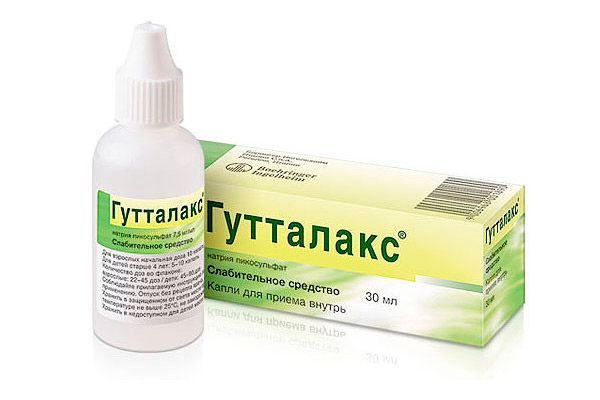
Active components are absorbed from the gastrointestinal tract and do not undergo enterohepatic circulation. When it enters the large intestine, it is transformed into an active form – free diphenol. It is available in the form of drops in special bottles of 15 and 30 ml. 1 ml of the preparation contains 4,4-(2-Picolylidene)-diphenol sulfate and 7.5 mg of sodium picosulfate.
- Indications for use: constipation caused by decreased colon motility, poor nutrition, excess weight. Bowel cleansing before surgery, X-ray or instrumental examination. Facilitation of defecation in patients with hemorrhoids, anal fissures and in the postoperative period.
- Contraindications: for children under 4 years of age, in the first trimester of pregnancy, and in case of intolerance to the components of the drug. Not used in case of intestinal obstruction, gastrointestinal bleeding, strangulated hernia, cystitis, acute inflammatory lesions of the abdominal cavity, abdominal pain of unknown genesis.
- The drug is taken orally, preferably before bedtime, so that defecation occurs in the morning (the effect occurs in 6-10 hours). For children from 4 to 12 years old, 5-10 drops dissolved in a small amount of water. For adult patients, 10 drops or more. In case of persistent constipation, the dosage can be increased to 15 drops. Dose adjustment depends on the results of treatment.
- Long-term use of the drug or failure to follow doctor's recommendations may provoke adverse reactions. Symptoms of overdose are intestinal colic, clinically significant loss of electrolytes and potassium, diarrhea. General weakness, loss of appetite, convulsions are possible. Symptomatic therapy is used for treatment.
- Regulax
A laxative used for gastrointestinal diseases. Its mechanism of action is based on chemical irritation of the intestinal mucosa. It has two forms of release: tablets and drops. The active components of the drug belong to the anthranoin group.
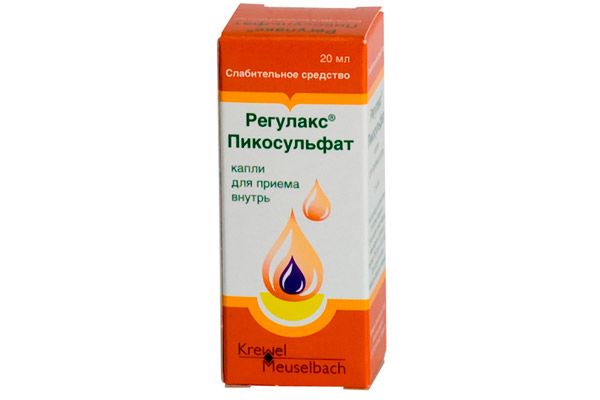
The active substance is reinantron, a metabolite of plant sennosides of senna. Stimulates intestinal motility and propulsive contractions.
- The drug is prescribed to accelerate the movement of intestinal contents, reduce resorptive processes with liquid. This helps in the treatment of chronic and short-term constipation. Regulax stimulates chlorine secretion, increasing the release of electrolytes and water into the intestinal lumen. Its effect develops 8 hours after taking the first dose.
- The dosage and duration of therapy are selected for each patient individually. Drops are used for children over 12 years old. Contraindicated in case of hypersensitivity to active components, Crohn's disease, appendicitis, intestinal obstruction, spastic constipation, pregnancy, nausea and vomiting, gastrointestinal bleeding.
- Main side effects: severe diarrhea, myocardial disorders, abdominal pain of a spastic nature, skin allergic reactions, change in urine color, hematuria, generalized exanthema, myasthenia. In case of overdose, the above-described signs appear for treatment, which use symptomatic therapy.
- Weakened
A synthetic drug with a laxative effect in the form of drops.

Enhances intestinal peristalsis, slows down the absorption of water in the intestine, preventing the hardening of feces. This leads to normal emptying, prevents spasms and tenesmus.
- The medicine helps with impaired and difficult defecation. It is used for timely emptying of the colon in sedentary patients. It is suitable for cleansing the intestines during diagnostic and instrumental procedures, in obstetric and gynecological practice.
- Drops are taken orally, added to food or drink. For children from 4 to 10 years old, 5-8 drops are prescribed once, increasing the dosage to 15 drops if necessary. Patients over 10 years old are prescribed 10-20 drops.
- The drops are contraindicated in cases of abdominal pain of unknown etiology, intestinal obstruction, and inflammation in the abdominal cavity. They are not prescribed for the treatment of patients under 4 years of age and in case of intolerance to the active components. If these recommendations are not followed, side effects occur. Most often, patients experience discomfort in the abdominal area, water-electrolyte imbalance, general weakness, and dizziness.
- Long-term use may provoke the formation of kidney stones, hyperkalemia, intestinal mucosal necrosis, dehydration. Antispasmodics are used for treatment and water-electrolyte balance is corrected.
- Picolax
Drops for eliminating problems with defecation. They contain sodium picosulfate, which after metabolism in the large intestine is transformed into diphenol. The active substance affects the receptors of the intestinal mucosa, increasing peristalsis and movement of feces.
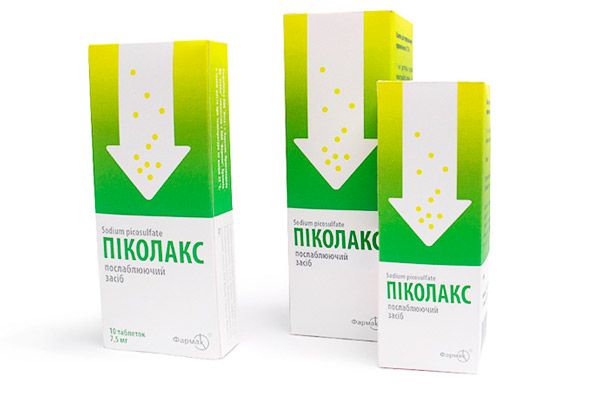
The drops are intended for oral use, are not absorbed into the systemic bloodstream, and the therapeutic effect occurs within 6-12 hours.
- Indications for use: treatment and prevention of constipation, elimination of problems with defecation in children over 4 years old and adults. Prescribed for cancer patients who take opioid analgesics. The medicine is taken in the evening, adding to food or diluting with water. For children from 4 to 10 years old - 7-13 drops 1 time per day, for children from 10 years old and adults - 13-27 drops per day. The duration of therapy is individual for each patient, but, as a rule, does not exceed three days.
- Contraindicated for use in case of intolerance to the components of the product and intolerance to fructose. Not prescribed for children under 4 years of age, during pregnancy and lactation, in case of obstructive intestinal obstruction, nausea and vomiting, abdominal pain of unknown etiology. With special caution used for the treatment of patients with hypokalemia, hypermagnesemia and for elderly patients.
- As a rule, the drug is well tolerated. In isolated cases, side effects occur, which manifest themselves in the form of disorders of the gastrointestinal tract (diarrhea, nausea, vomiting, colic, flatulence), central nervous system (headaches, sleep disturbances, convulsions, increased fatigue) and allergic reactions (itching, urticaria, rash).
- In case of overdose, diarrhea, decreased potassium levels in the blood and disturbances of water-electrolyte balance, spastic abdominal pain are observed. Ischemia of the mucous membrane of the large intestine and renal dysfunction are also possible. There is no specific antidote, therefore gastric lavage, intake of enterosorbents and symptomatic therapy are indicated.
- Portalak
Stimulates intestinal peristalsis, has a pronounced hyperosmotic and laxative effect.
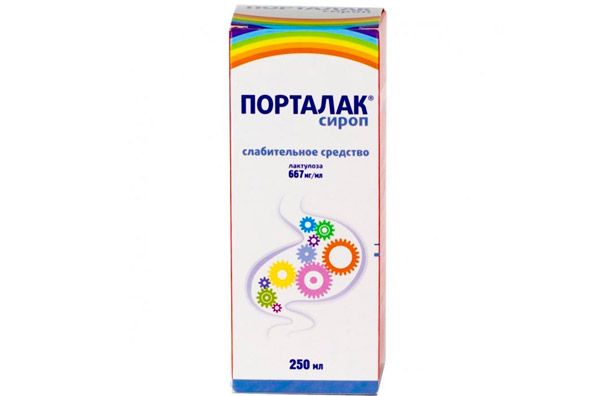
The active substance is lactulose, which inhibits pathogenic flora and creates a favorable environment in the intestine for the reproduction of lacto- and bifidobacteria. The drug affects the endothelial mucosa and the muscles of the large intestine, normalizes the physiological rhythm of digestion.
- Laxatives are prescribed for children from the first days of life. Drops help with constipation of various origins, for softening feces, with dysbacteriosis with difficult bowel movement, enteritis, hyperammonemia, hepatic encephalopathy, precoma and putrefactive dyspepsia syndrome.
- The daily dose of the medicine is taken once in the first half of the day, washed down with water or mixed with food. For children under one year old, 5 ml per day is prescribed, from 1-6 years old - 5-10 ml, from 7-14 years old - 15 ml and for patients over 14 years old - 14-75 ml per day. The therapeutic effect occurs two days after the start of treatment, after which the dosage is reduced and the drug is taken as a maintenance agent. If the desired effect does not occur within 2-3 days, the dosage is increased. The duration of treatment for severe constipation is 1-4 months.
- Portalac is prohibited in case of intolerance to its components, intestinal obstruction, appendicitis or suspicion of its presence, galactosemia, gastrointestinal perforation, rectal bleeding.
- Side effects may occur in the first days of taking the drug. Most often, patients experience flatulence, spasms and pain in the abdomen, diarrhea. These reactions are reversible, to eliminate them it is necessary to reduce the dosage. In case of overdose, diarrhea and water-electrolyte imbalance appear. The doctor adjusts the dosage, if the patient's condition does not improve, the drug is discontinued.
Drops for constipation for newborns
From the first days of life, the child's digestive system is not fully formed, so frequent dyspeptic disorders occur. The inability to fully defecate causes discomfort and pain in the gastrointestinal tract, the child becomes capricious and cries.
Drops for constipation for newborns are a simple and effective method for eliminating problems with bowel movements and normalizing their functioning.
- Normolact
Osmotic laxative with lactulose. Used to treat constipation, intestinal dysbacteriosis, intoxication, liver failure and encephalopathy.

Helps with putrefactive dyspepsia syndrome in infants, pain syndrome after removal of hemorrhoids and for softening feces.
- The medicine is contraindicated in case of individual intolerance to its components, intestinal obstruction, galactosemia. It is used with caution for the treatment of patients with diabetes mellitus, gastrocardial syndrome, during pregnancy and lactation.
- The method of application is individual for each patient. Children are prescribed oral administration with the highest dose, which is gradually reduced after 2-3 days after achieving the desired result. For newborns, 2.5-5 ml per day is prescribed, for children from 1-7 years old - 5-10 ml, from 7-14 - 15 ml, from 14 years and older - 15-45 ml. It is better to take the entire daily dose in the morning during breakfast, mixing with a drink or food.
- The use of high doses causes abdominal pain and diarrhea. Side effects manifest themselves in the form of the following symptoms: flatulence, nausea, diarrhea, headaches and dizziness, weakness, water-electrolyte metabolism disorders, arrhythmia, myalgia. As a treatment, it is recommended to reduce the dosage or stop therapy.
- Duphalac
Hypoammonemic laxative with the active ingredient lactulose.

Stimulates intestinal peristalsis, removes ammonium ions, improves absorption of calcium salts and phosphates. Has low absorption, reaches the large intestine unchanged, is broken down by intestinal flora.
- Indications for use: constipation, regulation of physiological emptying, softening of stool, hepatic encephalopathy in adult patients. Contraindicated in intestinal obstruction, gastrointestinal perforation, galactosemia, galactose or fructose intolerance, hypersensitivity to active substances.
- For children under one year, 5 ml per day is prescribed, from 1-6 years old - 5-10 ml, from 7-14 years old - 15 ml, for teenagers and adults - 15-45 ml per day. The duration of therapy is individual for each patient and is selected by the doctor. In case of overdose, abdominal pain and diarrhea appear. To eliminate them, you must stop taking the medicine and seek medical help.
- Side effects may appear in the first days of treatment. As a rule, this is flatulence, which goes away on its own after a few days. There may be a violation of the water-electrolyte balance, pain in the abdomen, nausea and vomiting.
- Prelax
An effective remedy, the pharmacological action of which is based on the suppression of opportunistic microflora and a decrease in the pH of the contents of the large intestine.
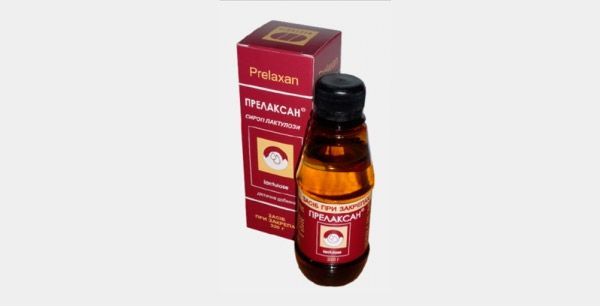
Prelax stimulates peristalsis, increases the amount of lactobacilli and bifidobacteria, improves the quality and speed of movement of feces. Does not irritate the intestinal mucosa, does not cause addiction and withdrawal syndrome.
- Indications for use: constipation of varying severity, postoperative period, hepatic encephalopathy, cleansing the body before diagnostic or surgical procedures. Can be used for preventive purposes in the development of dysbacteriosis.
- The method of administration and dosage are individual for each patient. As a rule, newborns are prescribed 2-4 doses per day. The drug is allowed during pregnancy and lactation. It is prohibited in case of lactose intolerance and hypersensitivity to the components of the drug. Side effects are manifested in the form of flatulence, abdominal pain. Attacks of vomiting and nausea are possible, which pass on their own within a few days.
Constipation drops for newborns can only be used with the appropriate doctor's prescription. Self-administration of medications is dangerous for the baby's health, as it can provoke a number of side effects that will only worsen the work of the gastrointestinal tract and intestines.
How to use drops for constipation for children
To achieve the desired therapeutic effect, the dosage and method of application of drops for constipation for children are selected by the doctor. The drug is taken orally, that is, washed down with a small amount of liquid, added to tea or juice, mixed with food. Most laxatives are recommended to be used in the first half of the day, that is, during or before breakfast. Drops taken before bedtime ensure bowel movement in the morning.
The dosage is calculated based on the child's weight. For newborns, 3-5 drops are prescribed, for children aged one year and older, 5-15 drops. Some medications require the use of increased dosages in the first days of treatment with subsequent reduction. The duration of therapy depends on the effectiveness of the drug and the doctor's prescriptions.
Contraindications for use
When choosing any medications for children, it is necessary to take into account their features and contraindications for use. Different groups of laxatives have a number of restrictions due to possible side effects.
Drops for constipation are not taken if you have the following diseases:
- Esophageal obstruction
- Various allergic reactions (rash, shock, asphyxia, Stevens-Johnson syndrome)
- Enterocolitis
- Small intestinal dysfunction
- Oncological lesions of the gastrointestinal tract
- Hepatitis and cirrhosis
- Intestinal obstruction
- Lipid pneumonia
- Severe itching in the anus
The drugs are not prescribed to children with intestinal inflammation, anorectal fissures, rectal bleeding and hypersensitivity to the active components.
Side effects
Some drugs that soften stool, improve intestinal peristalsis and ensure better sliding of the contents of the colon can cause adverse symptoms. Side effects occur in many organs and systems, most often in children the following reactions occur:
- Attacks of nausea and vomiting
- Cramps and pain in the abdominal area
- Diarrhea
- Dehydration (change in water-electrolyte balance)
- Skin allergic reactions
- Headaches and dizziness
- Fainting state
As a rule, no specific antidote is used to eliminate these side effects. Patients are shown symptomatic and supportive therapy and mandatory referral to medical care.
Overdose
The use of high doses of laxatives or exceeding the recommended course of treatment causes overdose symptoms. Most often, patients experience the following reactions:
- Diarrhea
- Dehydration
- Water and electrolyte imbalance
- Cramps and pain in the abdominal area
- Hypokalemia
- Lowering blood pressure
- Colonic smooth muscle ischemia
- Urolithiasis
To treat an overdose, it is recommended to induce vomiting and perform gastric lavage. To correct the electrolyte balance and replenish fluid in the body, take antispasmodics.
Interactions with other drugs
Very often, several medications are used to treat a particular pathological condition. Drops for constipation for children and their interactions with other drugs are controlled by the attending physician. Let's consider possible reactions using Guttalax as an example:
- High doses of laxatives in combination with GCS or diuretics increase the risk of developing hypokalemia (electrolyte disturbances).
- Electrolyte imbalances lead to increased sensitivity to cardiac glycosides.
- Antibiotics inhibit the laxative effect.
In any case, the use of several drugs simultaneously for the treatment of pediatric patients is possible only with the appropriate medical permission to prevent side effects.
Storage conditions
To preserve the pharmacological properties of a medicinal product of any form of release, it is necessary to observe the storage conditions. It is recommended to keep drops for constipation in the original packaging, out of the reach of children, protected from moisture and sunlight.
The recommended storage temperature is from 10 °C to 25 °C. If these instructions are not followed, the medicine loses its physical, chemical and medicinal properties (sediment and turbidity, unpleasant odor, color changes appear) and is prohibited for the treatment of both children and adult patients.
Best before date
Children's drops for constipation have a certain shelf life during which they can be used. As a rule, a laxative is allowed for 36 months from the date of manufacture, provided that the drug has not been opened. If an individual bottle of drops has been opened, it is allowed for 28 days, provided that the storage conditions are met.
Attention!
To simplify the perception of information, this instruction for use of the drug "Constipation drops for children" translated and presented in a special form on the basis of the official instructions for medical use of the drug. Before use read the annotation that came directly to medicines.
Description provided for informational purposes and is not a guide to self-healing. The need for this drug, the purpose of the treatment regimen, methods and dose of the drug is determined solely by the attending physician. Self-medication is dangerous for your health.


 [
[